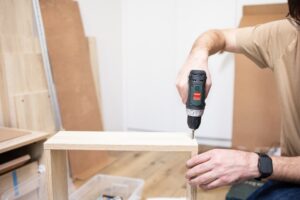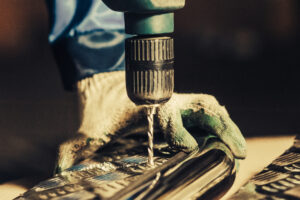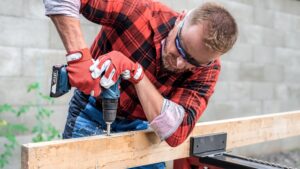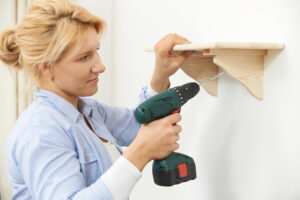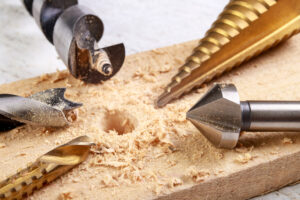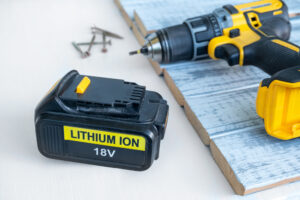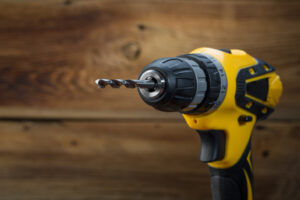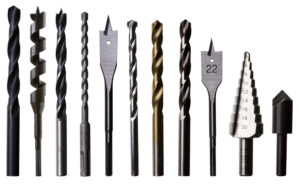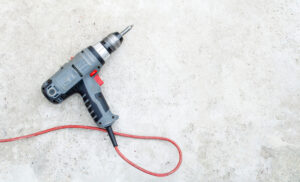When working with powered hand drills, it is important to follow certain safety precautions to protect yourself and ensure proper usage. Some key safety measures include selecting the proper bit or attachment, wearing safety glasses or a face shield, keeping drill air vents clear, and securing the workpiece being drilled. It is also important to avoid using bent drill bits, exceeding the manufacturer’s recommended drilling capacities, and using high-speed steel bits without cooling or lubrication.
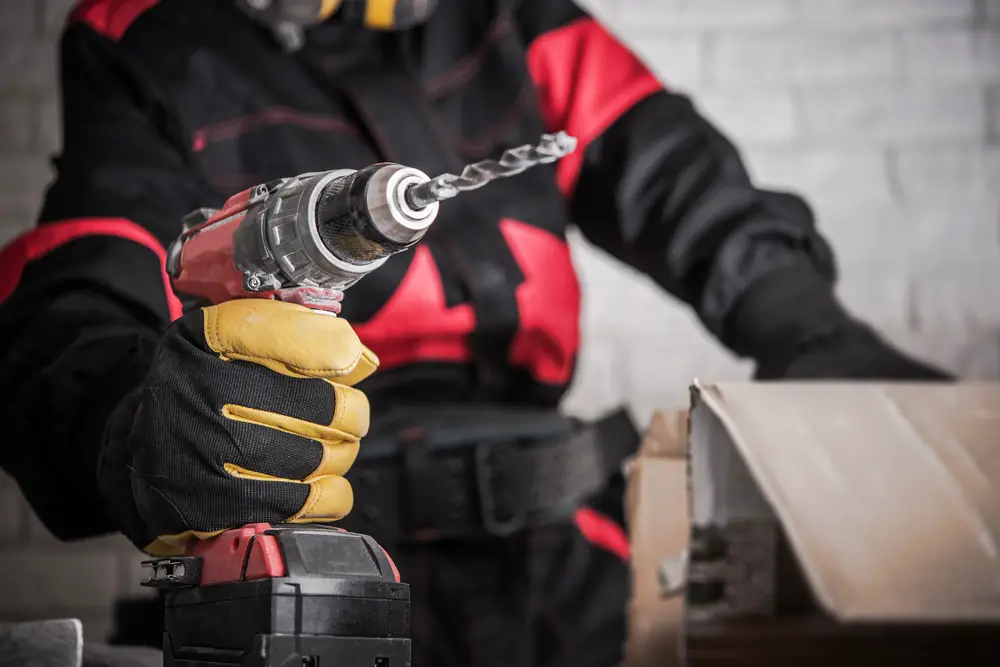
Key Takeaways:
- Choose the appropriate bit or attachment for safe drilling.
- Wear safety glasses or a face shield to protect your eyes.
- Keep drill air vents clear for proper ventilation.
- Secure the workpiece to prevent movement during drilling.
- Avoid using bent drill bits and exceeding recommended drilling capacities.
Selecting the Proper Bit or Attachment
When selecting a bit or attachment, it is important to consider compatibility with the drill. The bit or attachment should be properly seated and tightened in the chuck to ensure stability during the drilling process. Using bits and attachments that turn true without wobbling or vibrating will help maintain precision and avoid accidents.
If you are working on larger projects or engaging in continuous drilling, it is advisable to use the auxiliary handle. This additional handle provides better control and stability, reducing the risk of slippage or mishandling.
| Drill Size | Bit/Attachment Size | Recommended Use |
|---|---|---|
| Small | 1mm – 4.5mm | Drilling small holes in delicate materials |
| Medium | 5mm – 10mm | Drilling holes in average-sized materials |
| Large | 11mm – 19mm | Drilling large holes in thicker materials |
Safety Precautions When Working with Powered Hand Drills
When working with powered hand drills, it is crucial to prioritize safety and take necessary precautions to ensure a safe and efficient drilling experience.
1. Wear Safety Glasses or a Face Shield
Protect your eyes by wearing safety glasses or a face shield while operating the drill. This will safeguard against flying debris and potential eye injuries.
2. Maintain Ventilation
Ensure proper ventilation by keeping the drill air vents clear. Adequate airflow is essential to prevent overheating and maintain optimal drill performance.
3. Check Drill Bit Sharpness
Always use a sharp drill bit. Dull bits may cause the drill to slip or become difficult to control, increasing the risk of accidents. Regularly inspect and replace worn-out or damaged drill bits.
4. Secure Cords and Inspect for Damage
Keep cords clear of the cutting area to avoid accidental entanglements. Before each use, inspect the cords for any frays or damage. Damaged cords should be repaired or replaced to prevent electrical hazards.
5. Follow Proper Bit and Attachment Procedures
When changing or adjusting drill bits or attachments, disconnect the power supply and ensure the chuck is securely tightened. Following these procedures will prevent unintended bit releases and maintain safe drill operations.
6. Secure the Workpiece and Use a Pilot Hole
Ensure the workpiece is securely held in place to prevent movement or slips during drilling. When drilling large holes, it is recommended to start with a small “pilot” hole to guide the drilling process and minimize the risk of the drill wandering.
| Safety Precautions | Description |
|---|---|
| Wear Safety Glasses or a Face Shield | To protect the eyes from debris |
| Maintain Ventilation | Keep drill air vents clear for adequate airflow |
| Check Drill Bit Sharpness | Use sharp drill bits to ensure control and prevent accidents |
| Secure Cords and Inspect for Damage | Prevent entanglements and address damaged cords for safety |
| Follow Proper Bit and Attachment Procedures | Disconnect power and securely tighten the chuck when changing or adjusting bits |
| Secure the Workpiece and Use a Pilot Hole | Prevent workpiece movement and use a guide hole for better control |
Safety Precautions When Working with Small Pieces
Taking specific safety precautions can help protect you and prevent accidents or damage to your workpiece. Here are some key measures to keep in mind:
Clamp the Stock
One important safety precaution is to securely clamp the stock before drilling. This helps prevent the piece from twisting or spinning during the drilling process, ensuring stability and control.
Use Both Hands
It is strongly recommended to use both hands while drilling small pieces. Avoid the temptation to hold the material with one hand and drill with the other. This practice can lead to a loss of control, increasing the risk of accidents or injuries. By using both hands, you can have better control over the drill and maintain stability throughout the drilling process.
| Safety Precautions When Working with Small Pieces |
|---|
| 1. Clamp the Stock |
| Securely clamp the stock to prevent twisting or spinning during drilling. |
| 2. Use Both Hands |
| Always use both hands while drilling small pieces to maintain control and stability. |
What to Avoid When Working with Powered Hand Drills
To ensure drilling safety and prevent accidents, it is important to be aware of the actions and practices to avoid when working with powered hand drills.
Avoid using Bent Drill Bits
Using a bent drill bit can lead to unstable drilling and increase the chances of the bit breaking or snapping during operation. For optimal drilling performance and safety, always inspect the drill bits before use and replace any that are bent or damaged.
Avoid Exceeding Drilling Capacities
Exceeding the manufacturer’s recommended maximum drilling capacities can put excessive strain on the drill and compromise its functionality. It is important to refer to the drill’s user manual or specifications to determine the maximum drilling capacity and ensure that you stay within the prescribed limits.
Avoid Neglecting to Use Pilot Drills with Hole Saw Cutters
When using hole saw cutters, it is crucial to always use pilot drills. The pilot drill helps guide the saw cutter accurately and prevents it from wandering or slipping during operation.
Avoid Using High-Speed Steel (HSS) Bits without Cooling or Lubrication
High-speed steel (HSS) bits generate a significant amount of heat during drilling. It is essential to use cooling or lubrication methods, such as applying cutting fluids, to prevent overheating and premature wear of the drill bit. Avoiding the use of HSS bits without cooling or lubrication can enhance drill longevity and maintain drilling safety.
Avoid Trying to Free a Jammed Bit by Starting and Stopping the Drill
If a drill bit becomes jammed during operation, it is crucial not to attempt to free it by repeatedly starting and stopping the drill. Instead, unplug the drill from the power source and carefully remove the bit from the workpiece to avoid further damage or injury. This approach ensures a safer resolution to the issue.
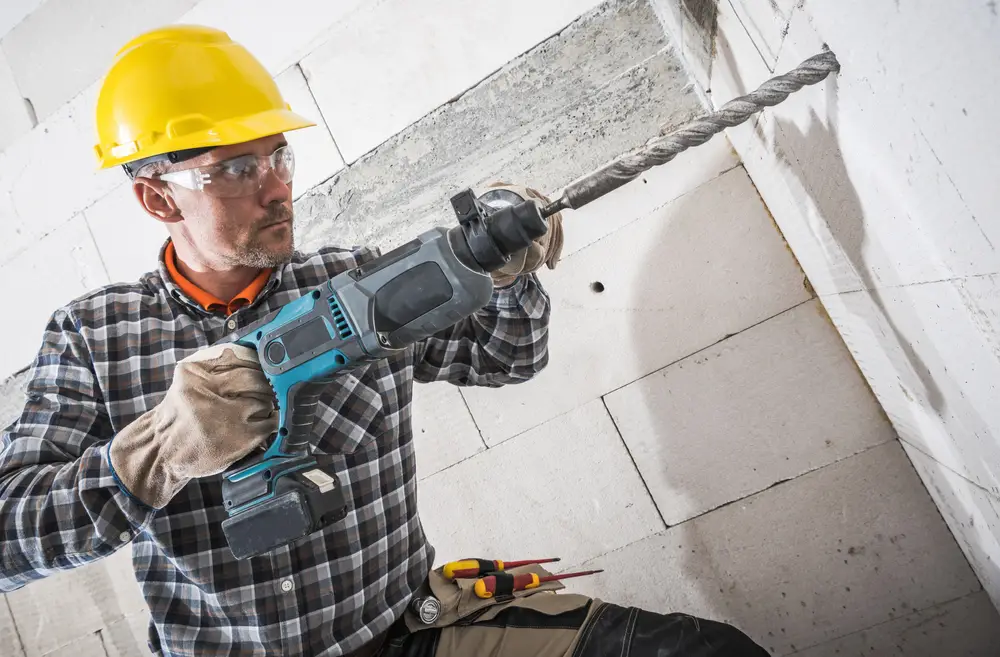
| What to Avoid | Reason |
|---|---|
| Using Bent Drill Bits | Increases the risk of bit breakage and compromised drilling stability. |
| Exceeding Drilling Capacities | Places excessive strain on the drill and compromises its functionality. |
| Neglecting to Use Pilot Drills with Hole Saw Cutters | May result in inaccurate cuts, damaged workpieces, and increased risk of accidents. |
| Using HSS Bits without Cooling or Lubrication | Can lead to overheating, premature wear of the drill bit, and potential drilling hazards. |
| Trying to Free a Jammed Bit by Starting and Stopping the Drill | Presents a risk of further damage or injury, requiring a safer approach to resolve the issue. |
Tips for Cordless Drill Safety and Usage
When it comes to using cordless drills, safety should always be a top priority. Here are some key measures you should keep in mind:
1. Wear Safety Goggles
Protecting your eyes is crucial when using a cordless drill. Always wear safety goggles to shield your eyes from flying debris or any potential hazards.
2. Use the Drill at the Correct RPM
Matching the drill’s RPM (Rotations Per Minute) to the specific drill bit and material is vital for safe drilling. Consult the drill’s manual or the bit manufacturer’s guidelines to ensure you’re using the correct RPM setting.
3. Secure the Workpiece
To prevent accidents and maintain control over the drilling process, it’s essential to always secure the workpiece. Use a vise or clamp to hold the workpiece securely in place, ensuring stability and reducing the risk of slipping.
4. Choose the Right Drill Bit
Using a correct ground drill bit appropriate for the material being drilled is crucial. This ensures optimal performance and reduces the likelihood of the bit getting stuck or causing damage.
5. Remove Chips Safely
After drilling, use a brush to remove chips from the drilled hole instead of doing it by hand. This prevents accidental injuries and keeps your hands out of harm’s way.
6. Ease Up on Drilling Pressure
When the drill bit is about to break through the material, it’s important to ease up on the drilling pressure. This prevents the bit from suddenly bursting through, reducing the risk of losing control over the drill.
7. Support the Part Being Drilled
When drilling through material, especially thin or delicate pieces, it’s advisable to support the part on parallels or a backing board. This additional support helps maintain stability and prevents the material from breaking or splintering.
Remember to always prioritize safety and take the necessary precautions to protect yourself and those around you.
Importance of Protective Clothing and Safety Gear
To ensure personal safety while drilling, it is essential to wear protective clothing and safety gear.
Safety Goggles
One of the most crucial pieces of safety gear is safety goggles. These goggles provide protection for your eyes against flying debris, dust, and other potential hazards. It is important to wear them at all times during drilling to prevent eye injuries.
Respiratory Masks
Drilling can create dust particles and fine particles that are harmful if inhaled. To mitigate this risk, it is recommended to wear respiratory masks that provide adequate filtration. These masks prevent the inhalation of drilling dust, ensuring your respiratory health.
Gloves
Properly fitted gloves are essential for protecting your hands while drilling. They provide a barrier between your skin and potential hazards such as hot surfaces and sharp objects. Wearing gloves can help prevent cuts, burns, and other hand injuries.
By wearing the appropriate protective clothing and safety gear, including safety goggles, respiratory masks, and gloves, you can significantly reduce the risk of injury or harm.
Safety Gear for Drilling
| Protective Gear | Description |
|---|---|
| Safety Goggles | Protects the eyes from flying debris and dust |
| Respiratory Masks | Prevents the inhalation of drilling dust particles |
| Gloves | Provides hand protection against heat, sharp objects, and other hazards |
Conclusion
By following the key safety precautions outlined in this article, such as selecting the proper bit or attachment, wearing protective clothing and safety gear, and avoiding common mistakes, you can improve drilling safety and have a more effective and efficient drilling experience.
Safe drilling techniques, such as keeping drill air vents clear, securing the workpiece being drilled, and avoiding the use of bent drill bits or exceeding drilling capacities, will greatly minimize the risk of accidents or injuries.
By implementing these safety measures and utilizing safe drilling techniques, you can confidently and successfully undertake any drilling project, knowing that you have taken the necessary steps to safeguard yourself and others. Happy and safe drilling!
FAQ
What safety precautions should I follow when drilling?
When drilling, it is important to select the proper bit or attachment, wear safety glasses or a face shield, keep drill air vents clear, and secure the workpiece. Additionally, avoid using bent drill bits, exceeding manufacturer’s recommended drilling capacities, and using high-speed steel bits without cooling or lubrication.
How do I select the proper bit or attachment for drilling?
It is recommended to follow the manufacturer’s instructions and choose a bit or attachment suitable for the size of the drill and the work being done. The bit or attachment should be properly seated and tightened in the chuck, and only bits and attachments that turn true should be used. For larger work or continuous operation, it is advisable to use the auxiliary handle.
What safety precautions should I take when working with powered hand drills?
It is important to wear safety glasses or a face shield, keep the drill air vents clear, use a sharp drill bit, inspect cords for damage, disconnect power before changing or adjusting the bit or attachments, secure the workpiece, and drill a small “pilot” hole before drilling large holes.
What safety precautions should I take when working with small pieces?
When working with small pieces, it is important to clamp the stock to prevent twisting or spinning during drilling. Avoid drilling with one hand while holding the material with the other to maintain control.
What should I avoid when working with powered hand drills?
To ensure drilling safety, it is crucial not to use a bent drill bit or exceed the manufacturer’s recommended maximum drilling capacities. Always use the pilot drill when using a hole saw cutter and avoid using high-speed steel (HSS) bits without cooling or lubrication. If a bit becomes jammed, unplug the drill and remove the bit instead of trying to free it by starting and stopping the drill.
What tips should I follow for cordless drill safety and usage?
Some key cordless drill safety tips include wearing safety goggles, using the drill at the correct RPM for the drill bit and material, and always holding the workpiece in a vise or clamp. Use a correctly ground drill bit for the material being drilled and remove chips with a brush rather than by hand. Ease up on drilling pressure as the drill breaks through the material and support the part on parallels or a backing board when drilling through material.
Why is wearing protective clothing and safety gear important when drilling?
Wearing protective clothing and safety gear, such as safety goggles, respiratory masks, and gloves, is important to ensure personal safety. These items protect the eyes from flying debris, prevent the inhalation of drilling dust, and provide protection for the hands.
- Drill Battery Maintenance: Essential Tips for Cordless Drill Battery Care - February 5, 2024
- Troubleshooting Drill Issues - February 5, 2024
- Quick Drilling Techniques - February 2, 2024

